Global entertainment and media company Warner Bros. Discovery (NASDAQ:WBD) missed analysts' expectations in Q1 CY2024, with revenue down 6.9% year on year to $9.96 billion. It made a GAAP loss of $0.40 per share, improving from its loss of $0.44 per share in the same quarter last year.
Warner Bros. Discovery (WBD) Q1 CY2024 Highlights:
- Revenue: $9.96 billion vs analyst estimates of $10.22 billion (2.6% miss)
- EPS: -$0.40 vs analyst estimates of -$0.21 (-$0.19 miss)
- Gross Margin (GAAP): 39.2%, up from 37.5% in the same quarter last year
- Free Cash Flow of $390 million, down 88.2% from the previous quarter
- Market Capitalization: $19.11 billion
Formed from the merger of WarnerMedia and Discovery, Warner Bros. Discovery (NASDAQ:WBD) is a multinational media and entertainment company, offering television networks, streaming services, and film and television production.
The creation of Warner Bros. Discovery brought together WarnerMedia's extensive entertainment, sports, and news assets with Discovery's expertise in non-fiction and international entertainment. This merger was aimed to build a comprehensive media portfolio, ready to meet the changing consumption patterns and demand for diverse content across various platforms.
The company offers a wide range of entertainment options, including numerous TV networks, a collection of direct-to-consumer streaming services, and widespread film and TV production capabilities. Warner Bros. Discovery caters to the need for quality content across different genres and formats, ensuring a position in the global entertainment sector.
Warner Bros. Discovery's revenue is generated through content distribution, advertising, subscription services, and licensing. Its business model focuses on leveraging its extensive content library and global reach to deliver content to audiences worldwide.
Media
The advent of the internet changed how shows, films, music, and overall information flow. As a result, many media companies now face secular headwinds as attention shifts online. Some have made concerted efforts to adapt by introducing digital subscriptions, podcasts, and streaming platforms. Time will tell if their strategies succeed and which companies will emerge as the long-term winners.
Competitors in the local media and digital marketing industry include iHeartMedia (NASDAQ:IHRT), Cumulus Media (NASDAQ:CMLS), and Beasley Broadcast (NASDAQ:BBGI).Sales Growth
Reviewing a company's long-term performance can reveal insights into its business quality. Any business can have short-term success, but a top-tier one sustains growth for years. Warner Bros. Discovery's annualized revenue growth rate of 29.9% over the last five years was exceptional for a consumer discretionary business. 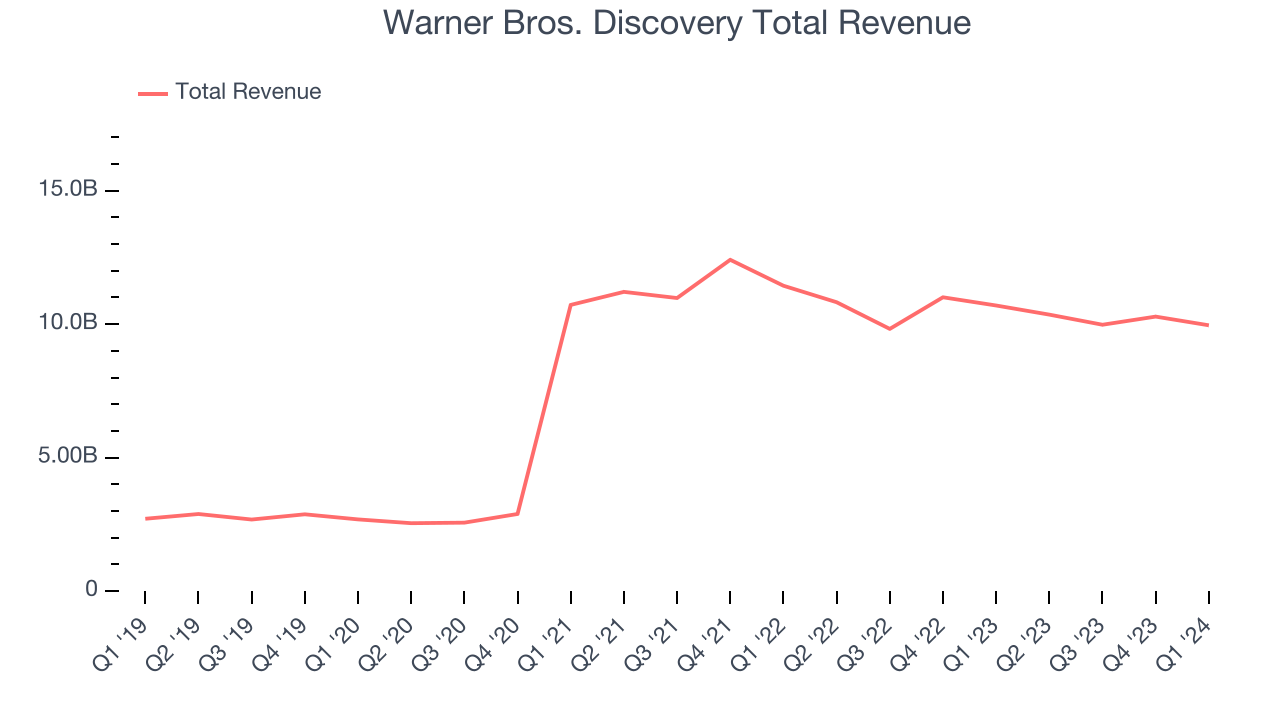 Within consumer discretionary, product cycles are short and revenue can be hit-driven due to rapidly changing trends. That's why we also follow short-term performance. Warner Bros. Discovery's recent history shows a reversal from its five-year trend, as its revenue has shown annualized declines of 6.1% over the last two years.
Within consumer discretionary, product cycles are short and revenue can be hit-driven due to rapidly changing trends. That's why we also follow short-term performance. Warner Bros. Discovery's recent history shows a reversal from its five-year trend, as its revenue has shown annualized declines of 6.1% over the last two years.
We can dig even further into the company's revenue dynamics by analyzing its three most important segments: Distribution, Advertising, and Content, which are 50.1%, 21.6%, and 25.7% of revenue. Over the last two years, Warner Bros. Discovery's revenues in all three segments declined.Distribution revenue (licensing fees) averaged year-on-year decreases of 2.4% while Advertising (marketing services) and Content (films, streaming, games) averaged drops of 10.4% and 9.7%.
This quarter, Warner Bros. Discovery missed Wall Street's estimates and reported a rather uninspiring 6.9% year-on-year revenue decline, generating $9.96 billion of revenue. Looking ahead, Wall Street expects sales to grow 2% over the next 12 months, an acceleration from this quarter.
Operating Margin
Operating margin is a key measure of profitability. Think of it as net income–the bottom line–excluding the impact of taxes and interest on debt, which are less connected to business fundamentals.
Given the consumer discretionary industry's volatile demand characteristics, unprofitable companies should be scrutinized. Over the last two years, Warner Bros. Discovery's high expenses have contributed to an average operating margin of negative 8.8%.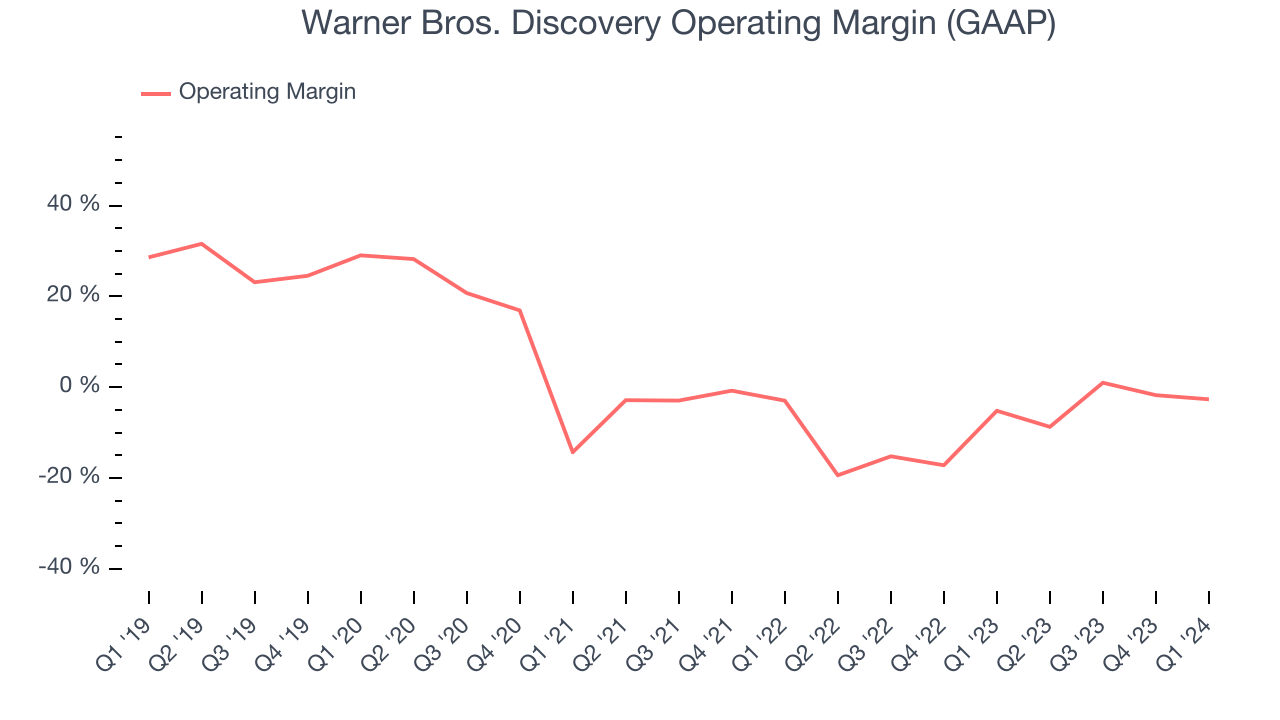
This quarter, Warner Bros. Discovery generated an operating profit margin of negative 2.7%, up 2.5 percentage points year on year.
Over the next 12 months, Wall Street expects Warner Bros. Discovery to become profitable. Analysts are expecting the company’s LTM operating margin of negative 3.1% to rise to positive 1.6%.EPS
We track long-term historical earnings per share (EPS) growth for the same reason as long-term revenue growth. Compared to revenue, however, EPS highlights whether a company's growth was profitable. 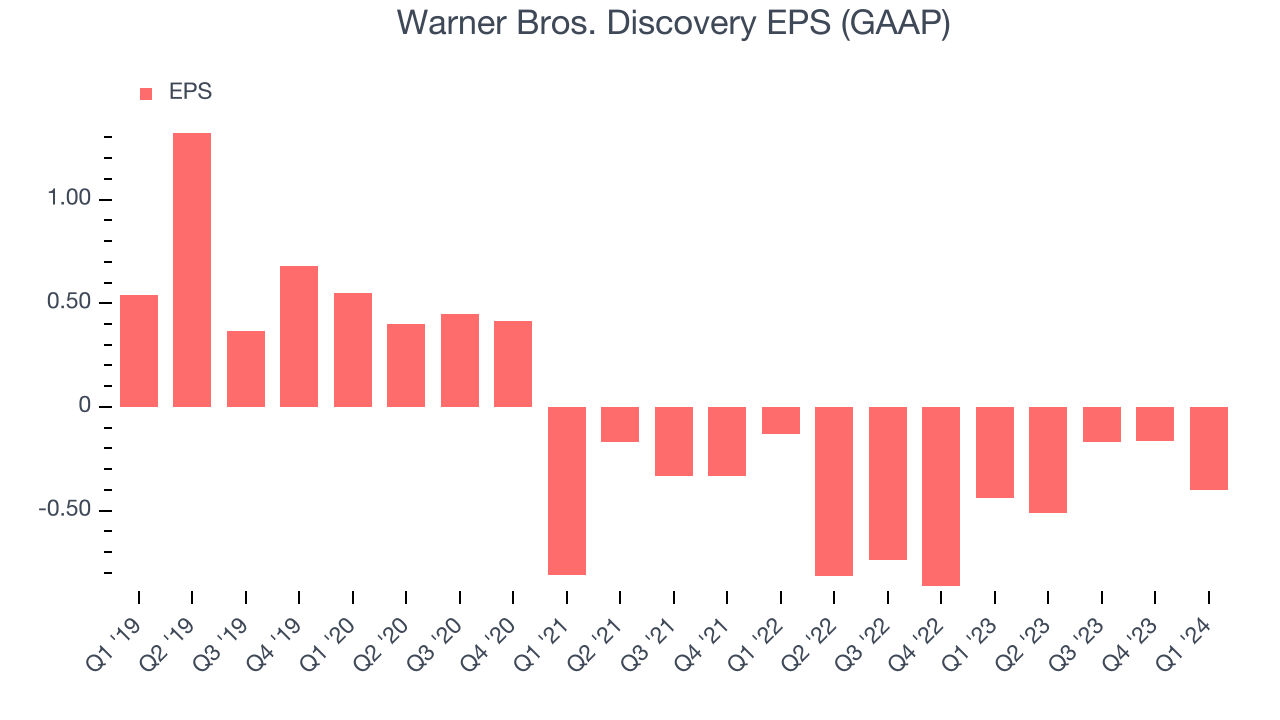
Over the last five years, Warner Bros. Discovery's EPS dropped 190%, translating into 23.7% annualized declines. We tend to steer our readers away from companies with falling EPS, where diminishing earnings could imply changing secular trends or consumer preferences. Consumer discretionary companies are particularly exposed to this, leaving a low margin of safety around the company (making the stock susceptible to large downward swings).
In Q1, Warner Bros. Discovery reported EPS at negative $0.40, up from negative $0.44 in the same quarter last year. Despite growing year on year, this print unfortunately missed analysts' estimates. Over the next 12 months, Wall Street is optimistic. Analysts are projecting Warner Bros. Discovery's LTM EPS of negative $1.24 to reach break even.
Cash Is King
Although earnings are undoubtedly valuable for assessing company performance, we believe cash is king because you can't use accounting profits to pay the bills.
Over the last two years, Warner Bros. Discovery has shown decent cash profitability, giving it some reinvestment opportunities. The company's free cash flow margin has averaged 11.6%, slightly better than the broader consumer discretionary sector.
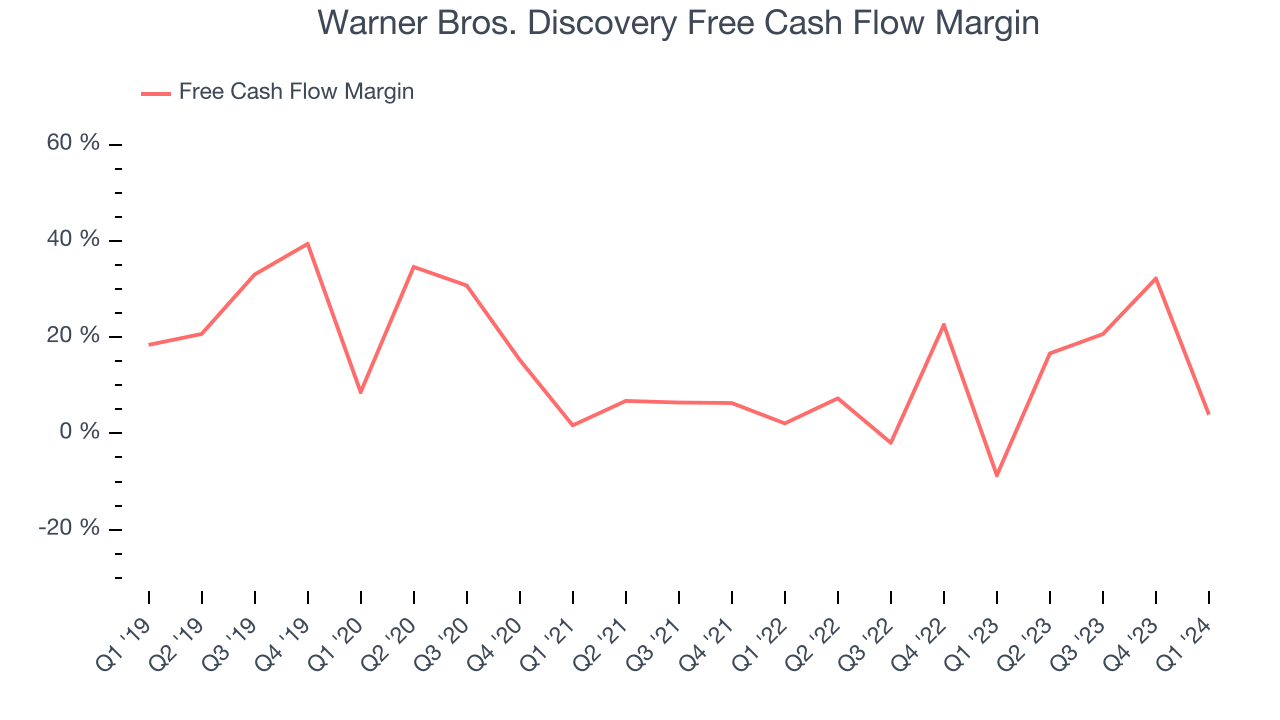
Warner Bros. Discovery's free cash flow came in at $390 million in Q1, equivalent to a 3.9% margin. This result was great for the business as it flipped from cash flow negative in the same quarter last year to cash flow positive this quarter. Over the next year, analysts predict Warner Bros. Discovery's cash profitability will fall. Their consensus estimates imply its LTM free cash flow margin of 18.4% will decrease to 12.9%.
Return on Invested Capital (ROIC)
EPS and free cash flow tell us whether a company was profitable while growing revenue. But was it capital-efficient? A company’s ROIC explains this by showing how much operating profit a company makes compared to how much money the business raised (debt and equity).
Warner Bros. Discovery's five-year average return on invested capital was 0.2%, somewhat low compared to the best consumer discretionary companies that pump out 25%+. Its returns suggest it historically did a subpar job investing in profitable business initiatives.
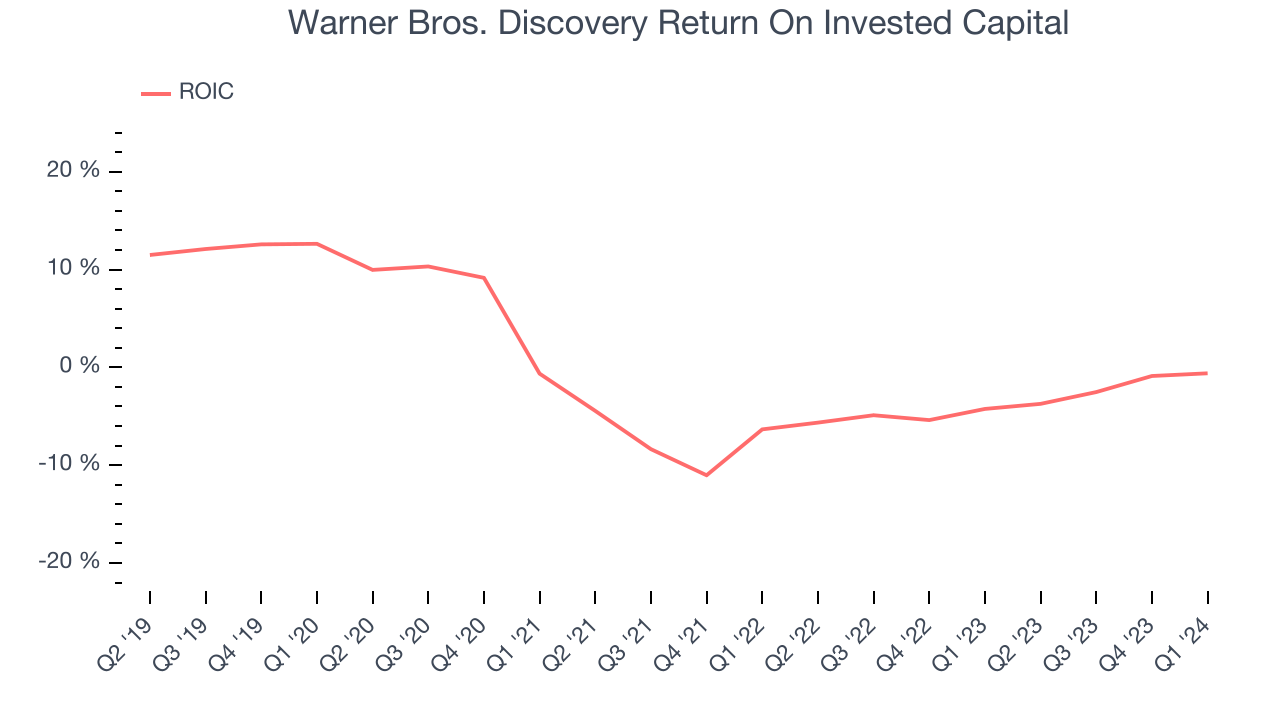
The trend in its ROIC, however, is often what surprises the market and drives the stock price. Unfortunately, Warner Bros. Discovery's ROIC averaged 8.4 percentage point decreases over the last few years. Paired with its already low returns, these declines suggest the company's profitable business opportunities are few and far between.
Balance Sheet Risk
Debt is a tool that can boost company returns but presents risks if used irresponsibly.
Warner Bros. Discovery reported $2.98 billion of cash and $42.58 billion of debt on its balance sheet in the most recent quarter. As investors in high-quality companies, we primarily focus on two things: 1) that a company's debt level isn't too high and 2) that its interest payments are not excessively burdening the business.
With $9.69 billion of EBITDA over the last 12 months, we view Warner Bros. Discovery's 4.1x net-debt-to-EBITDA ratio as safe. We also see its $2.03 billion of annual interest expenses as appropriate. The company's profits give it plenty of breathing room, allowing it to continue investing in new initiatives.
Key Takeaways from Warner Bros. Discovery's Q1 Results
We struggled to find many strong positives in these results. Its operating margin missed and its EPS fell short of Wall Street's estimates. Overall, this was a bad quarter for Warner Bros. Discovery. The company is down 3% on the results and currently trades at $7.55 per share.
Is Now The Time?
Warner Bros. Discovery may have had a tough quarter, but investors should also consider its valuation and business qualities when assessing the investment opportunity.
We cheer for all companies serving consumers, but in the case of Warner Bros. Discovery, we'll be cheering from the sidelines. Although its revenue growth has been exceptional over the last five years, its declining EPS over the last five years makes it hard to trust. And while its projected EPS for the next year implies the company's fundamentals will improve, the downside is its relatively low ROIC suggests it has historically struggled to find compelling business opportunities.
While we've no doubt one can find things to like about Warner Bros. Discovery, we think there are better opportunities elsewhere in the market. We don't see many reasons to get involved at the moment.
Wall Street analysts covering the company had a one-year price target of $13.01 per share right before these results (compared to the current share price of $7.55).
To get the best start with StockStory, check out our most recent stock picks, and then sign up for our earnings alerts by adding companies to your watchlist here. We typically have the quarterly earnings results analyzed within seconds of the data being released, and especially for companies reporting pre-market, this often gives investors the chance to react to the results before the market has fully absorbed the information.
